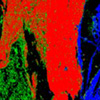| Aug 17, 2022 |
|
(Nanowerk News) Researchers have developed a label-free and non-invasive Raman spectroscopy approach that can acquire microscopic images of biological samples and identify a wide range of biomolecules with unprecedented speed and sensitivity.
|
|
“Our work could lead to a non-invasive, label-free and user-friendly device for clinical use,” said research team leader Dario Polli from Politecnico di Milano in Italy. “This innovative microscope, coupled with deep learning-based algorithms, could eventually make it easier and faster to diagnose cancer by allowing the visualization of the chemical constituents of human tissues and cells.”
|
 |
| The researchers used their CARS microscopy system to image a tissue sample from a mouse spine. The image shows the bone marrow region (green), muscle region (blue) and the bone tissue (red). (Image: Dario Polli, Politecnico di Milano)
|
|
In the journal Optics Express (“Fingerprint multiplex CARS at high speed based on supercontinuum generation in bulk media and deep learning spectral denoising”), the researchers describe their new technique, which is based on coherent anti-stokes Raman scattering (CARS) microscopy. CARS microscopy produces images based on the vibrational signatures of molecules by exploiting the interaction between ultrashort laser pulses and biological samples.
|
|
The new approach provides access to the hard-to-detect region of the vibrational spectrum known as the fingerprint region, which spans from 400 to 1800 cm−1. Although many individual compounds can be identified using their vibrational fingerprints in this region, it tends to produce weak signals that are difficult to detect.
|
|
“Commonly used techniques in biomedical sciences often require staining, which is not only cumbersome but can also introduce structural and chemical alterations that can lead to artifacts, or errors, in imaging and data processing,” said Polli. “Because our system can distinguish between many different chemical species in biological tissues without labels, it could be useful for live cell imaging and analyzing tissue biopsies.”
|
Lower repetition rate, faster imaging
|
|
This new work is part of the CRIMSON project funded by the European Commission, which aims to develop a turnkey imaging device that uses vibrational spectroscopy for fast cell and tissue classification. The project’s goal is to transform the study of the cellular origin of diseases to enable new approaches that could advance personalized therapy.
|
|
As a key step toward this goal, the researchers developed a CARS microscope based on a commercial laser that produces ultrashort pulses with durations of approximately 270 femtoseconds in the near-infrared wavelength range. They designed the microscopy system to use laser pulses with a repetition rate of 2 MHz, which is much lower than the 40 or 80 MHz used by most other CARS systems.
|
 |
| The new system uses a lower pulse repetition rate than other CARS systems. This allowed the researchers to generate broadband, red-shifted Stokes pulses that cover the whole fingerprint vibrational region using white-light supercontinuum generation in a bulk crystal (pictured). (Image: Dario Polli, Politecnico di Milano)
|
|
This lower repetition rate reduces photothermal damage to the sample because it creates a delay of 0.5 microseconds between two consecutive pulses. It also produces a higher pulse energy and peak intensity at the focal point, which generates a stronger CARS signal and allows a faster acquisition speed.
|
|
“The most important advantage of the lower repetition rate is that it allowed us to generate broadband, red-shifted Stokes pulses that cover the whole fingerprint vibrational region by using white-light supercontinuum generation in a bulk crystal,” said Federico Vernuccio, doctoral student at Politecnico di Milano and first author of the study. “Compared to other methods, this approach is technically simpler, more compact and robust.”
|
|
Using a spectral region that is red-shifted compared to standard setups means that higher laser intensities can be used before the onset of photodamage. The researchers also developed new algorithms that combine standard numerical computational approaches with artificial intelligence. These algorithms retrieve more information from the acquired data and turn it into images that allow different chemical species to be easily distinguished.
|
|
“Thanks to our improvements, the CARS system delivers high-quality images at a state-of-the-art acquisition speed,” said Vernuccio. “Our system has a less than 1 millisecond pixel dwell time without compromising sample integrity. This speed is limited by the spectrometer refresh rate.”
|
High speed sensitivity
|
|
To test their system, the researchers used reference samples to compare spectra retrieved with the new microscope with ones acquired using a state-of-the-art, although slower, vibrational spectroscopy technique. The two methods showed excellent agreement, demonstrating that the new system could deliver spectra at very high speeds with good spectral resolution and chemical specificity.
|
|
The researchers then determined the detection limit of their system by acquiring CARS spectra of a set of dimethyl sulfoxide solutions with various concentrations. The system was able to measure chemical concentration with the unprecedented sensitivity of 14.1 mmol/liter, around double the sensitivity of other CARS systems working in the fingerprint region.
|
|
They also showed the system’s ability to distinguish and spatially localize various transparent micron-sized plastic beads based on their vibrational signature and took measurements from biological tissues to demonstrate that the technique works on biological samples without inducing damage.
|
|
“Our CARS microscope allows label-free imaging with chemical specificity at higher speeds, thus making Raman imaging of living cells more feasible,” said Polli. “This could allow our system to be used to analyze the interactions of cancer cells with immune cells or to characterize how chemotherapy affects cells, for example.”
|
|
The researchers are now working to improve their system by creating an even broader wavelength range of Stokes pulses through white-light supercontinuum generation. This would improve both the speed of imaging and the number of detectable chemical analytes. They are also working toward commercialization by developing user-friendly software, compact optical sources and designs for a commercial prototype and detection system.
|



